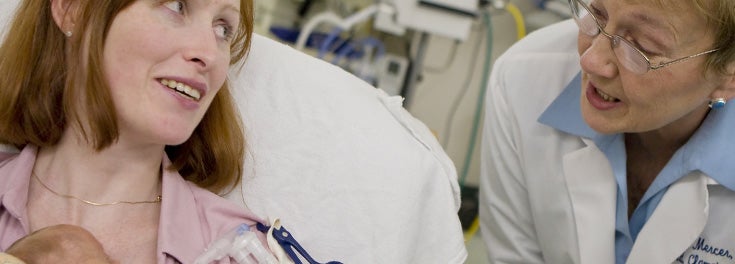
Every mommy-to-be and most couples know that a smooth pregnancy and delivery are all about timing — from getting pregnant, to the first kick, to when contractions begin and a new team takes over the count until the first cry is heard.
This safe cry is the signal for medical professionals to clamp the infant’s umbilical cord without delay. “But wait!” is the message now being heard worldwide that’s brought a big change in just when that cord is clamped.
It’s all about timing. This is a low tech change in clinical practice that respects the normal process of birth and makes a big change in outcome
URI Clinical Professor of Nursing Judith Mercer and her colleagues are making the call. They’ve found that a delay in clamping and cutting the cord is better for the baby. It allows the newborn to absorb more oxygen- and stem-cell-rich blood from the mother’s placenta. And it’s a brilliantly simple idea that’s received millions of dollars in research funding from the National Institutes of Health, the National Institute for Nursing Research and the Bill & Melinda Gates Foundation.
A certified nurse-midwife, Professor Mercer said she had thought for years that a delay could do wonders for a baby, especially one born prematurely. In fact, her research found that premature babies whose cords were clamped after a 30 to 45 second delay had significantly lower rates of bleeding in the brain and blood infections that are associated with developmental delays and conditions such as cerebral palsy. Babies whose cords had been clamped immediately developed such conditions.
Her research has eliminated previous concerns about delaying the cord clamping and has changed many standard practices. Now, the National Institutes of Health wants her to find out if doing the same thing for full-term babies will result in health benefits for them as well. She’s also advising a URI graduate student who is doing her doctoral thesis on the practice and effects for babies born via C-section.
“The fact is that cord blood contains stem cells, the body’s master cells that help it renew and repair its tissues. They are miraculous. We don’t know enough about them yet, but we arrogantly oftentimes cut that cord right away,” Professor Mercer said.
“If research continues to support delayed cord clamping and medical personnel perform this procedure, the effects may be well beyond the newborn,” the Professor says. “It’s all about timing. This is a low tech change in clinical practice that respects the normal process of birth and makes a big change in outcome.”
